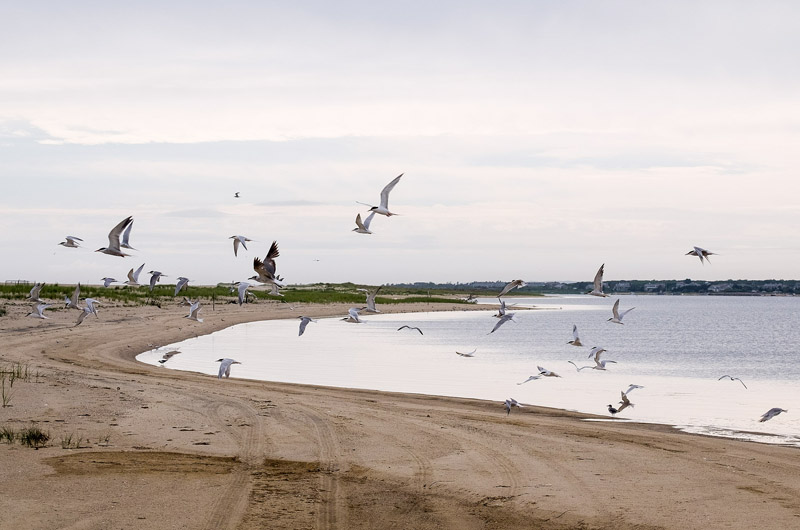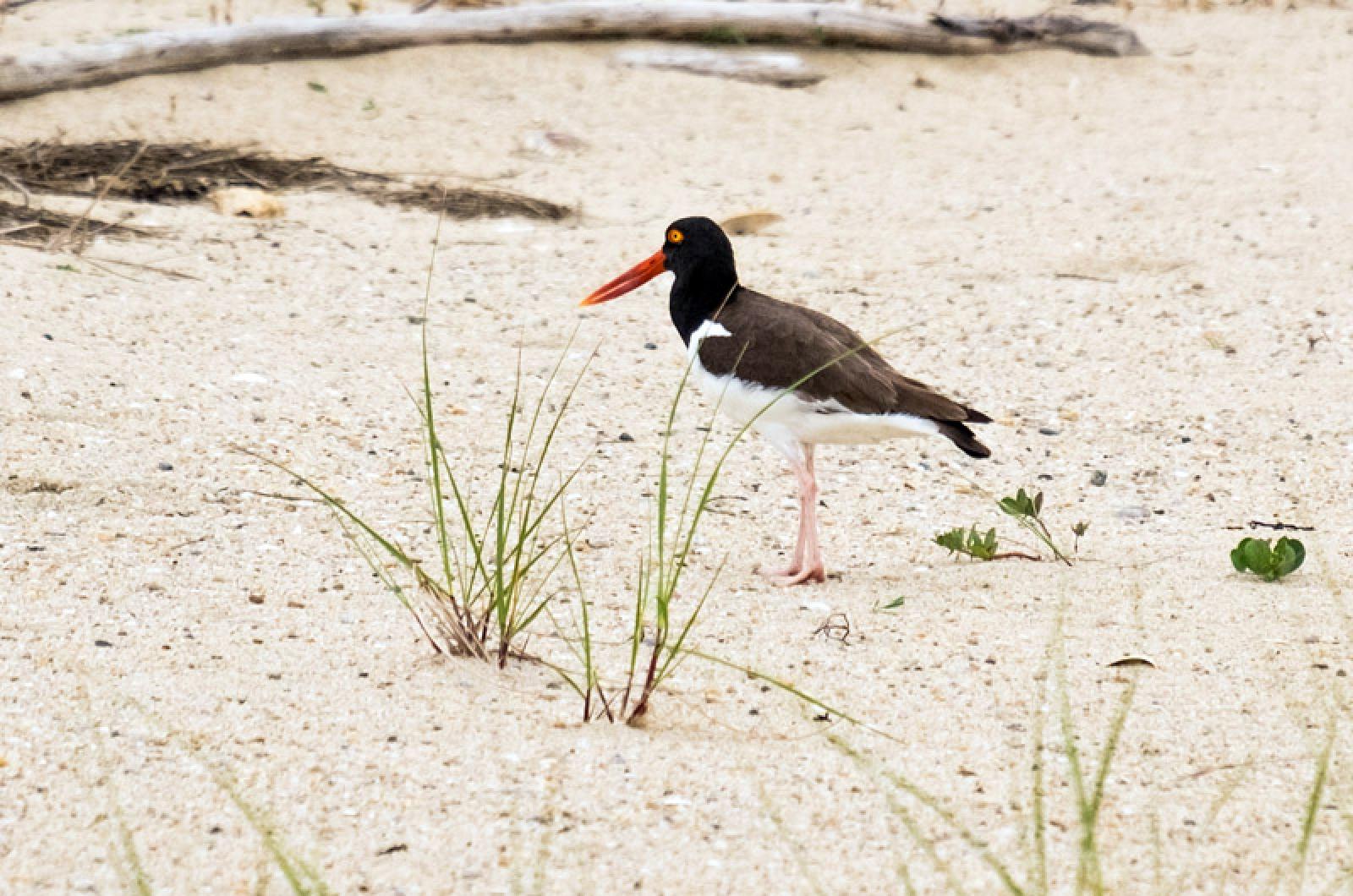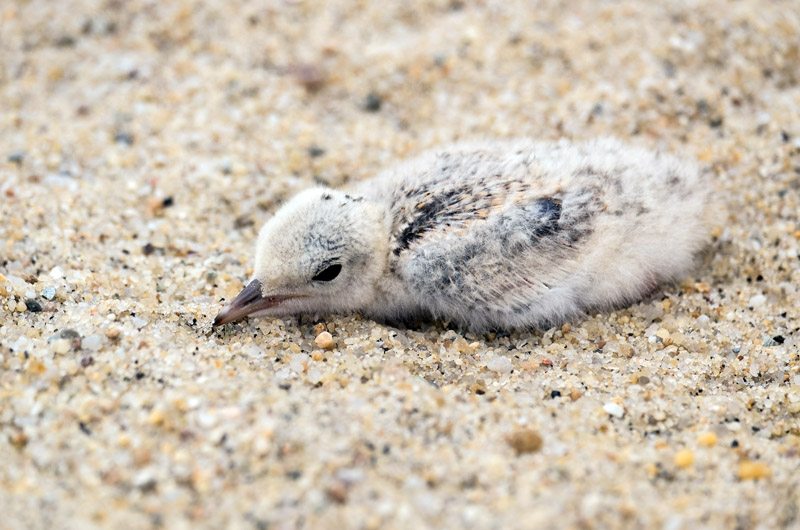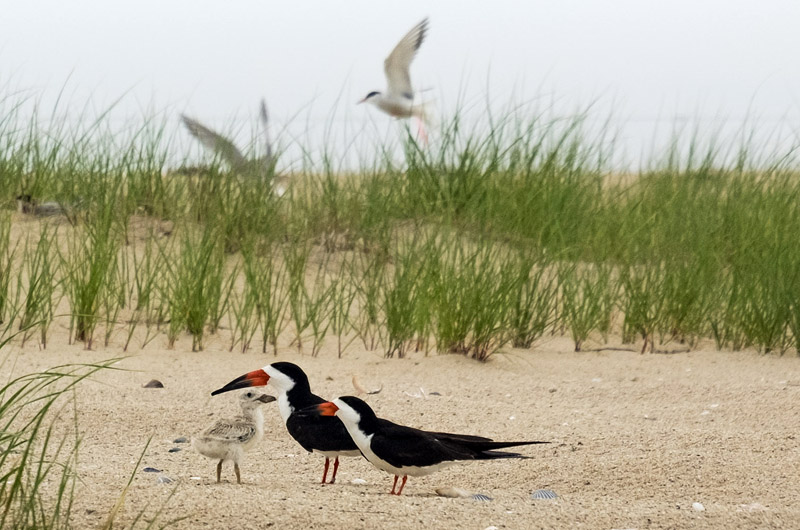The sky above Norton Point Beach was swarming with terns on a cloudy day this week, as tiny chicks — newly hatched and full of life — raced around on the sand below.
Caitlin Borck, who manages the shorebird program for the Trustees of Reservations on Chappaquiddick, inched along the beach in a large white pickup truck, eyes glued to the sand, where an occasional chick skittered by or hunkered down in the tire tracks — an instinctual response to their parent’s warning call.
Once or twice, Ms. Borck stopped and pointed out a clutch of small greenish eggs resting on the sand, hardly visible even from a few yards away. One tern chick, hiding in a tire track, refused to move, even when nudged with a finger, so Ms. Borck carefully drove around it and continued slowly down the beach, with a spotter walking ahead in the sand.
As usual at this time of year, the barrier beach from Wasque Point west along Katama Bay has been closed to over-sand vehicles as terns, plovers, black skimmers and oystercatchers lay their eggs and their chicks begin to hatch. For now, at least, the birds had free reign over a vast expanse of sand often dotted with surfcasters and streaked from one end to the other with tire tracks.
The closure of the Norton Point breach last year has created new habitat for the nesting shorebirds, all of which

have some form of legal protection, but here at least, appear to be thriving. A colony of common, least and roseate terns about two thirds of the way down the beach is among the largest in the state, and the trustees have counted at least eight pairs of piping plovers — double the number observed at Norton Point last year.
In light of rebounding plover populations statewide, the Division of Marine Fisheries and Wildlife has developed a new habitat conservation plan that makes it easier for communities to gain permits for foot and vehicle traffic in nesting areas.
The Trustees, which own and manage much of the open space on Chappaquiddick, plan to submit a so-called certificate of inclusion, which would allow visitors to self-navigate through key areas where nesting shorebirds prevent access to the beach. “The goal is to do this without causing a take, but that is always a possibility,” said Ms. Borck. The new rules would require, among other things, a spotter in front of the vehicle, and additional conservation measures in the area to offset the potential harm to birds.
The Trustees will likely submit their proposal in the coming days, but Ms. Borck believed it was likely too late in the season for the changes to have any effect this year.
Shorebirds begin to arrive on the Vineyard around March, although black skimmers and oystercatchers arrive somewhat later. This week roughly marked the halfway point in the nesting season, and Norton Point was the place to be. Some oystercatchers are now on their second mating attempt, Ms. Borck said, while tern chicks are hatching and fledging.
Here and there among the dunes, a round fence indicated the presence of a plover nest. One adult plover, resting warily on its clutch, fled through the wire fence when the truck approached, and let out a characteristic peep, which translates to “go away.” If the threat were to persist, Ms. Borck said, the adult may step up the drama by pretending to have a broken wing — a trick also employed by killdeer and other species to draw predators away from their nests. (Killdeer are also members of the plover family.)
Later, a plover landed right beside the truck and raced ahead before stopping and eyeing the intruder, an indication of a nest nearby. Ms. Borck assumed the nest was on the other side of the barrier beach (the ocean side), and planned to go back and check. But in some cases, especially on windy days where getting too close would cause stress to the birds, the behavior of adults is enough to confirm a nest.
Other notable changes this year include four pairs of nesting roseate terns — fewer than last year, but more than the previous two years when there were none. Ms. Borck believed their absence in the past was due to predators like skunks and crows. She also noted a somewhat unusual threesome of oyster catchers (two females and a male) watching the same nest, and a tagged plover from down south known to the Trustees as Bahama Jack.
The enclosures are effective at protecting plovers, but oystercatchers and black skimmers are generally too large for fencing to let them in and keep out the crows. And because terns tend to fly away from their nests rather than run, they would get stuck in the netting. To target the smartest crows, the Trustees build mock enclosures and bait them with chicken eggs. When all those eggs disappear, they replace them with ones laced with avicide. A number of skunk traps are also hidden among the dunes.
Besides the occasional crow, the nesting shorebirds share the beach with gulls, osprey and other coastal species. But the swarming terns and their chorus of chirping dominate that portion of the beach. All terns are highly territorial, which adds a certain flair to their flight patterns, as they swoop and dive at intruders. Now and then a juvenile will drop out of the sky and disappear onto the sand at the direction of an adult who spots danger.
The aggression and beauty mix in a kind of relentless ballet. At one point, a group of four black oyster catchers flew by in formation, each one with its long orange beak pointed down like the nose of a Concorde. Later, one pair got too close to the nest of another, and a wild chase of two against two ensued over the beach and water.
But on balance, it was something of a coastal Eden — far more easy to protect and preserve than to reproduce. At various points along the beach, Ms. Borck stopped the truck, got out and undid a thin rope that keeps out vehicles and pedestrians. After noting her presence in a log book, she restrung the rope and continued down the beach, leaving behind only two tire tracks in the sand.










Comments
Comment policy »